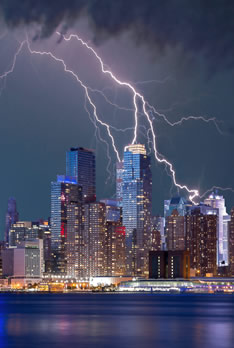Nature’s Power
Excerpt from Christina’s book, Natural Urges:
A year before I left Houston, a tropical storm dumped two days of unrelenting rain on our city. Hundreds of us walked, biked, or skated in the drenching downpour to lean over the bridges and watch Allen Parkway and Memorial Drive below turn into roiling rivers, submerging cars, vans, buses and delivery trucks under 30 feet of water. An evening newscaster was perplexed by why we were out in the storm. “It’s dangerous,” he fretted. “They should be home where it’s safe.”
Didn’t he know? We were feeding our souls.

Stock Photo
At first, I thought this was a Houstonian urge, so deprived are we of nature’s moods. On the Texas Gulf Coast, there’s little distinct seasonal variation, and the day-to-day changes are imperceptible unless you look closely. Mostly, it’s sunny with shades of hot all year. Air-conditioning, in buildings and vehicles, is life. In the nearly 20 years I lived there, the natural world became a constant, steady drone, a taken-for-granted backdrop for human activity.
In Seattle, my post-Houston home, the sky, water and mountains change continually. They are palpably alive. From my window, downtown Seattle’s 50-story buildings look like a Lego village, dwarfed by white-haired Mt. Rainier in the background 75 miles away. When that mammoth mountain erupts, it could wash us all into Puget Sound. Yet a native Seattleite complained, as we walked to a restaurant in just enough rain to bead on our jackets, “I don’t like this drizzle. I like hard, pounding rain and thunder, the kind of storm that lets you know it’s there. It rarely does that here.”
This desire for natural extremes is widespread. In Arizona, a line of lightning rods and cabins attracts vacationers hoping to witness nature’s electricity sizzling from pole to pole, even though they could get barbecued. Visitors from around the world brave 40 degree below zero weather to catch the aurora borealis streaming across the Alaskan sky. People hunker down with hurricane parties on the coasts, and camp out on Oregon’s ocean beaches to watch Pacific storms roll in.
It’s a soul thing, this thirst for nature’s power displayed. Now that we humans have trashed the earth’s skin, sucked the water, oil and minerals out of its veins, and insulated ourselves from its heat, cold, wind and rain, we seem to want evidence that our control over natural forces isn’t absolute. That nature is still alive, still bigger and more powerful than we are, and still part of us.
Our culture has nearly eliminated the natural in human systems. Separating the elderly and the young destroys our natural source of wisdom and of rejuvenation and growth. By living with our elders, we learn to accept the natural course of life. We see aging first-hand. We understand and expect that our bodies too will replace suppleness and firmness with wrinkles and sags, that our energy and our perspective on life will change with time and experience. By segregating the elderly from the young, we cut off our elders’ natural means of revitalization, their immersion in the heart of life, and their place in the natural progression of generations. We stunt our own sense of history and belonging and leave the elderly lonesome, bored and waiting to die.
Nor do we have a natural way of dealing with our dead. With contemporary burial practices, we’re embalmed and vaulted. The decomposing that naturally takes a decade or two could take a century or more. With cremation, decomposition takes only a few hours, so we’re rushed away and may even believe that we have no right to lay our bodies in the earth when land is needed for the living.
The conscious awareness that we live on a living being that possesses the same life energy we do is growing. Some people are finding ways to live lightly on the earth. Many are trying to re-integrate the natural into existing systems, growing organic food, eating vegetarian, moving to rural areas, using wind and solar power, and struggling for limits via the WTO protests and biotechnology resistance.
But these attempts can get distorted when we try to do them within systems not conducive to them. For example, we move to the country and start trying to change it. We bring urban amenities, get rid of pests, ants, dust, and odors, and instead of becoming part of the existing community, we create a separate one, or keep to ourselves. We’ll buy hormone-free meat, eco-fish, shade-grown coffee, and organic vegetables, if we can afford them, while the rest of our food system gets pumped full of hormones and synthetic substances.
Connected by spirit, we are not separate and cannot isolate ourselves. The wounds we create or leave for others will eventually return to us in one form or another through this connecting cord. Our systems need to change so these ways of living become the policy and practice of our society. When we create social systems that support and nourish the natural cycles, processes, and characteristics of life, they will support our physical, emotional and spiritual needs. If we don’t, we’ll make human life more vacuous, more vicious, and more toxic.
We may ultimately destroy ourselves. But we won’t destroy the planet. Mother Earth will shudder and shake us off, swallow us up, crush us under our own constructions. What naiveté or hubris to think otherwise! In the struggle for life, we’re no match for the forces of the universe. We can learn to live in harmony with them, or they will live without us. Like all children, we are testing the limits.
